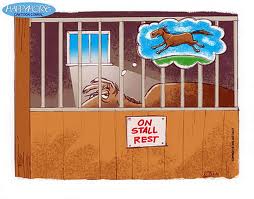How to keep your horse “comfy” on stall rest
by horselover2
 This is a four-part series which focuses on various problems often associated with stall confinement. A range of solutions are provided to help make the horses’ stall rest more tolerable for horse and owner.
This is a four-part series which focuses on various problems often associated with stall confinement. A range of solutions are provided to help make the horses’ stall rest more tolerable for horse and owner.
Inevitably, it is common for a horse to be placed on stall rest for one reason or another at some point in his/her life. Extended stall rest can be stressful for both horse and owner. Often, after a few days of confinement, a horse will “acquire” destructive behaviors such as cribbing, chewing, kicking, or pawing. In addition, many horses will also show signs of extreme anxiety.
Unfortunately, long-term stall rest is often not a choice. Horses are commonly placed on stall rest by their veterinarian due to injury. Ultimately, the goal is for the horse to heal as quickly as possible. However, the side effects of stall confinement are anxiety and the development of destructive behaviors. In turn, owners must look for ways to “survive” the allotted stall rest with the least amount of physical and/or psychological damage to the horse or themselves. By taking location, feed management, limited exercise, and entertainment into consideration, it is possible to make this experience relatively painless.
The first factor that should be considered when a horse is on stall rest is location. Although some owners may not have an option as to where their horse is stalled, if it is possible, a change in the horse’s location can make stall rest easier to bear. A horse on stall rest should be placed in a stall where he/she has a clear view of outside activities. This way, the horse can at least participate in “normal” daily activities as a spectator. If the horse is able to watch what is going on around him/her, it will help keep the animal occupied.
Whether the horses stall location can or cannot be moved, it is important to make sure your horse is as comfortable as possible in his/her stall. Consequently, owners must make sure the horse has a clean and padded stall. This can be attained by insuring the horse has clean shavings and is standing on rubber mats. Since the horse will be confined to a small area with little or no exercise for days at a time, owners need to make sure there is no additional strain to the horse’s body.
Standing on concrete or packed dirt with little room to stretch could cause this additional strain. If employees standing behind a checkout counter for four hours at a time are provided with padded mats to minimize discomfort, shouldn’t a horse that is going to be in a stall for an extended period of time be assigned the same care?
One other option owners should consider is setting up a fan/ mister during the summer months or a heat lamp during the winter months to provide the horse with a more comfortable environment. Making sure the horse is as comfortable as possible will help the animal heal quicker and could also help prevent the horse from developing hard-to-stop vices.
Related Articles
- Helping Horses With Herd-Bound Behavior (tellingtonttouch.wordpress.com)



[…] Read the rest… […]